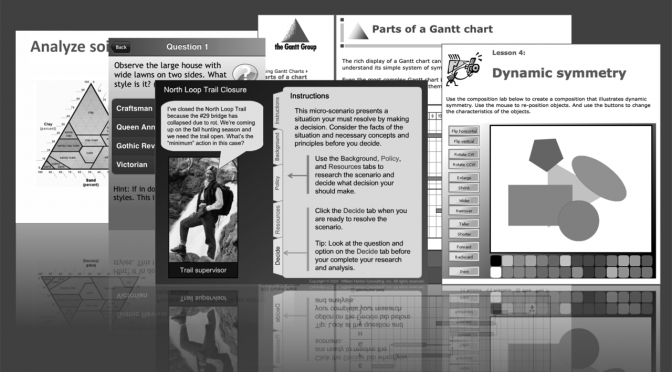Here is a guided research activity. This approach is effective when you wish to teach higher-level decision skills. It starts with the decision that needs to be made. If learners understand the implications, they can make the decision right away. If the decision is the correct one, learners may move to the next micro-scenario and … Continue reading Closing the North Loop Trail →
This is an example of a tutorial that helps learners make the connection between commands in a programming language and their result in the real world. About this example Audience: Machine operators with low verbal skills. Purpose: To help operators connect a word command that appears on a milling machine to a physical procedure. Context: … Continue reading Introduction to: SLaCT →
Concepts for Object-Oriented Programming is an example of asynchronous e-learning. It employs a mixture of narrated animations and self-practice activities to help learners understand the object-oriented concepts of inheritance and overriding. About the example Audience: Experienced programmers who are switching to an object-oriented programming language. Purpose: To explain the concept of inheritance and overrides. Context: … Continue reading Concepts for object-oriented programming →
How the critical path affects project completion time is an example of a short, asynchronous course. It employs a mixture of narrated animations and self-practice activities to help learners understand the significance of the critical path and task dependencies. About the example This example was built in PowerPoint. Other tools were used along the way. … Continue reading Using the critical path →
The Hydrologic Cycle is a learning object that explains the processes of the hydrologic cycle. It employs a mixture of activities. It contains a narrated animation, a review/summary, a self practice game, and a page of additional resources. About the example This example was built in PowerPoint. Other tools were used along the way. TextAloud … Continue reading Hydrologic cycle review →
We have designed and built courses for a number of clients. They cover a variety of topics from how to use a software product to developing spiritual values. Here is a list of examples from projects we have designed and produced. Some of these courses are publicly available and you can view them live. Others … Continue reading E-learning courses and sample lessons →

We have posted many examples of work we have done in the e-learning, documentation, and knowledge management arenas. Some are the actual client project. Others are sanitized versions. We have categorized them into some broad grouping. Choose a category to see a list of specific examples. Try them out. Let us know what you think about … Continue reading E-learning examples →
2000, 130 pages, Adobe Part Number ZWA52M100 Published by Adobe, Inc. (previously Macromedia) Get it today! for FREE! from Adobe William Horton has contributed two chapters to this exceptional little e-book about how to get started with online learning. Here’s how Adobe describes it: This book is designed to help new authors create learning applications … Continue reading Getting Started with E-learning →
Using E-learning Preface What Is This Book About? Who Should Read It? How Is This Book Different? Section I: The New World of Training Chapter 1: The Potential of E-Learning Using E-Learning for Organizational Purposes Redefining E-Learning As a Tool What E-Learning Can Do What E-Learning Cannot Do Your Turn Chapter 2: Catalog of E-Learning … Continue reading Table of contents →
Using E-learning Welcome to the post-hype era of e-learning. In the hyper-hyped phase of e-learning’s evolution, organizations developed and deployed e-learning because that was the thing to do. Some projects succeeded but many did not. Claims of 1000+% return on investment were common but seldom verified by any standard accounting principles. Training, and e-learning in … Continue reading Preface →
